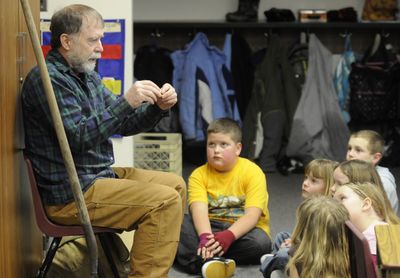Retired educator tells stories with a purpose

The kids quickly flowed into a semicircle surrounding Dan Conley one recent afternoon, sitting quietly with rapt attention as they waited for him to begin telling stories.
Conley, who has been visiting his son, John Conley’s, combined second- and third-grade class about every two weeks this year, is something of a grandfather figure for the kids. He tells several stories on each visit to Skyview Elementary, most of them based on experiences he had growing up. All his stories include messages about positive character traits.
“The kids have grown to like him,” said John Conley. “Who doesn’t like a good story?”
During his most recent visit, Dan Conley told a story about the school’s principal, Chiere Martyn. He and Martyn grew up together on Mount Kit Carson behind Mount Spokane. The way Dan Conley tells it, Martyn’s father was a former professional baseball player who built a baseball field in his yard. All the boys on the mountain would come to play, but there were only eight of them, so Martyn was often asked to play. “She could hit and run as fast as the boys,” he said.
But those were the days when girls just didn’t play baseball. So when the team would play other local teams, Martyn would stuff her hair up under her baseball cap and pretend to be a boy. But not for long. “By the third inning, she’d have something to say,” Dan Conley said. “She’d always slide in (to base) on purpose so her hat would fall off.”
The revelation that a girl was playing always caused a stir, but her teammates didn’t care. “It didn’t matter if she was a boy or a girl,” he said. “By then, us boys realized this was a dumb rule.”
The theme of girls being able to do whatever they wanted to was continued in his next story about a girl who collected eagle feathers even though girls weren’t allowed to. Other stories told about a pig who taught a bird to fly, a boy who found acceptance in a rough-and-tumble logging camp, and a bear that came to love garbage more than his natural food before becoming reformed.
Some of the stories Dan Conley told are in his book “Ray of Hope,” a book about storytelling for teachers. Conley said he’s been telling and listening to stories all his life, going to back when he was a boy and neighbors would gather to swap tales. “I can remember when there was no TV,” he said. “I can remember when there was no electricity.”
Dan Conley, 56, recently retired after working for the Riverside School District for 22 years. He spent most of his career at Riverside working as a physical therapist to children up to age 6 who had developmental delays. He was previously a teacher and also worked for Central Valley for 11 years. During all those years, he told stories.
All the stories are original, either telling a true story or in some way based on actual events. Dan and John Conley craft the stories together. All have a message, but some aren’t explicit. It depends on the age of his audience, Dan Conley said.
The “Garbage Rat Bear” story about the bear that preferred trash is really about drug addiction, he said. He emphasized how the bear beat his problem with the help of people who cared about him. He had all the students list someone who cares about them, getting responses ranging from mom to police officers.
“There are a lot of people who care about you,” he said. “You’re never alone.”
The drug abuse aspect of it will be brought up later in a way that’s age appropriate, he said. “John will talk about it,” he said. “He knows his kids and how best to go about it. Stories shouldn’t be preachy. Stories should be innocent.”
Conley said one of his favorite parts of telling stories is when the kids get totally involved in the tales. “In their head, they’re seeing the pictures. They forget to blink and their eyes start to twinkle.”
He believes that telling stories is important because of how it affects the imagination. “Imagination is what causes you to be creative. Without creativity you can’t solve problems.”
During his visit, he also showed the students how to make music by hitting a metal saw with a small mallet, bending it just so. “Cool, he’s a musician,” said one boy.
Having fun telling the stories is just a bonus. And the hugs he gets as the students leave are icing on the cake. “Girls, don’t forget, slide into first base,” he said as they walked out the door.